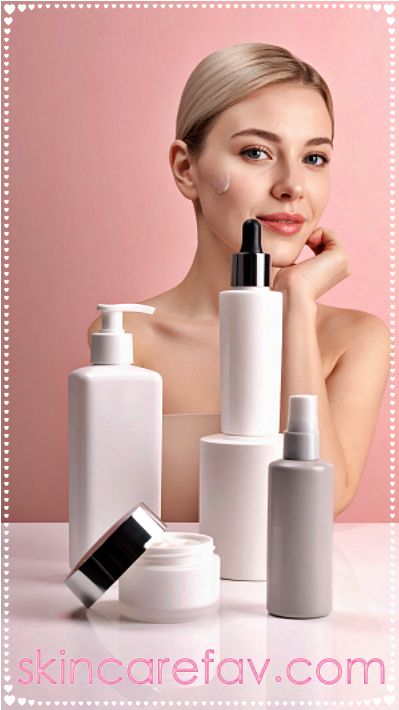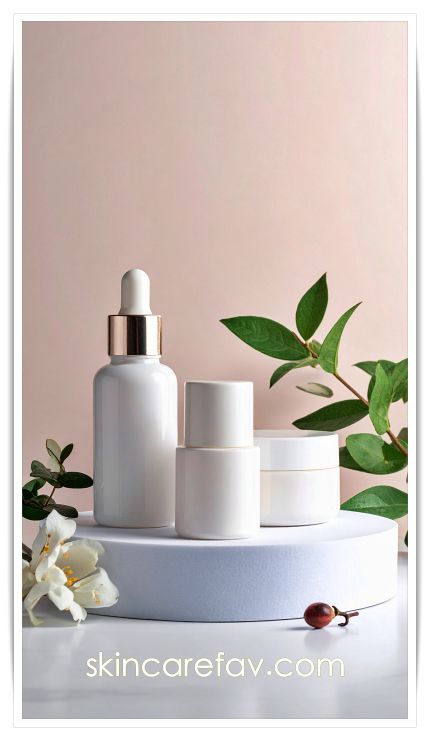Step-by-Step Skincare Routine for Healthy, Glowing Skin
When it comes to skincare, consistency beats complexity every single time. You don’t need a 15-step routine or a cabinet full of products — what you really need is to understand the right steps for a skincare routine and how to apply each product in the right order.

Note: This Page was last updated on Wednesday 5th of November 2025
Whether you’re a beginner or a skincare enthusiast trying to fine-tune your routine, this guide will walk you through every step — from cleansing to moisturizing — so you can finally achieve that healthy, glowing skin you’ve been after.
Let’s dive into your perfect daily skincare routine!
Why the Order of Your Skincare Routine Matters
Before we get into the steps, let’s make one thing clear: the order you apply your skincare products can make or break your results.
Think of your skin like a sponge. If you start with thick creams, lighter serums won’t penetrate properly. But if you layer products from lightest to heaviest, each one works more effectively.
In short — the right order = maximum results.

Morning Skincare Routine Steps
Your morning routine should protect your skin from UV rays, pollution and dehydration throughout the day.
Here’s a simple, dermatologist-approved order you can follow:
Step 1: Cleanser
Start your day by washing away sweat, oil and any product residue from the night before. Use a gentle cleanser that matches your skin type — foaming cleansers work great for oily skin, while hydrating gel or cream cleansers are ideal for dry or sensitive skin.
Pro Tip: Avoid hot water; lukewarm water helps maintain your skin’s natural barrier.
Step 2: Toner
Toner is your skin’s “reset button.” It balances pH, removes leftover residue and preps the skin to absorb serums better.
If you have dry or sensitive skin, go for an alcohol-free hydrating toner with ingredients like rose water or hyaluronic acid.
Common Mistake: Skipping toner because it “dries you out” — that’s only true for alcohol-heavy formulas. Modern toners actually nourish the skin.
Step 3: Serum
Serums are where the real magic happens. They’re packed with active ingredients that target specific concerns — think hydration, brightening or anti-aging.
- For dullness: Try a Vitamin C serum.
- For dryness: Go for Hyaluronic Acid.
- For fine lines: Use a Peptide or Niacinamide serum.
Pro Tip: Apply your serum on slightly damp skin for better absorption.
Step 4: Moisturizer
Even if you have oily skin, moisturizer is non-negotiable. It locks in hydration and seals all the previous layers.
Choose a lightweight gel moisturizer if you’re oily or a richer cream if your skin is dry or mature.
Common Mistake: Using too much product. A pea-sized amount is usually enough for the entire face.
Step 5: Sunscreen
Your last — and most important — step. Sunscreen is your daily armor.
Use a broad-spectrum SPF 30 or higher, even if you’re staying indoors. UV rays can penetrate windows and cause long-term damage.
Pro Tip: Don’t forget your neck, ears and the back of your hands — the most commonly neglected areas.

Night Skincare Routine Steps
While your morning routine protects, your nighttime routine repairs. This is when your skin regenerates and absorbs active ingredients best.
Step 1: Double Cleanse
Start with an oil-based cleanser to remove makeup and sunscreen, then follow with a water-based cleanser to clean deeper.
Pro Tip: This two-step cleansing method prevents clogged pores and helps your night products work more effectively.
Step 2: Toner (or Essence)
Use a hydrating toner or essence to rebalance your skin after cleansing. If you love that “glass skin” look, choose one with fermented ingredients or glycerin for an instant glow.
Step 3: Treatment Serum
Nighttime is the perfect moment for stronger actives:
- Retinol for fine lines and cell turnover.
- Niacinamide for oil control and brightness.
- AHA/BHA (1–2 times a week) for gentle exfoliation.
Always introduce actives slowly and avoid layering too many potent ingredients together.
Step 4: Eye Cream
Your eye area is thinner and more delicate, so treat it with care. Look for an eye cream with caffeine for puffiness or peptides for fine lines.
Pro Tip: Apply using your ring finger — it applies the least pressure.
Step 5: Moisturizer or Night Cream
Lock in all that goodness with a nourishing night cream or sleeping mask. For oily or acne-prone skin, a light gel formula works best. For dry or mature skin, choose something rich with ceramides or shea butter.

Optional (But Worth It) Weekly Treatments
These aren’t daily steps, but adding them once or twice a week can really upgrade your skincare game:
|
Treatment Type |
When to Use |
Skin Benefit |
| Exfoliating Mask | 1–2 times/week | Removes dead skin cells, boosts glow |
| Clay Mask | 1–2 times/week | Reduces oil and clears pores |
| Hydrating Sheet Mask | 2–3 times/week | Deep hydration and plump skin |
Pro Tip: Never exfoliate on the same night you use retinol — it can irritate your skin barrier.
Building a Routine for Your Skin Type
No two skins are the same — and neither should their routines be. Here’s a quick guide:
- Dry Skin: Use creamy cleansers, rich moisturizers and hydrating serums (like Hyaluronic Acid).
- Oily Skin: Stick to lightweight, non-comedogenic products.
- Combination Skin: Balance both — gel cleanser, light moisturizer.
- Sensitive Skin: Avoid fragrance and alcohol; stick to soothing ingredients like aloe or ceramide.
Want to discover your personalized routine? Check out our Complete Skincare Routine Guide
How to Layer Your Products — Order & Timing (Simple Rules)
Getting the order right is half the battle. Use this quick rule: thin to thick, active to occlusive. Apply each product and wait ~30 seconds to a minute for it to absorb (especially serums and lightweight actives). Here’s a straightforward layering routine you can follow:
1. Cleanser — remove dirt and prep the skin.
2. Toner / Essence — rebalances pH and adds light hydration.
3. Water-based serums (hyaluronic acid, vitamin C) — these absorb fast and should be applied early.
4. Treatment serums (niacinamide, peptides, retinol at night) — apply after hydrating serums; retinol goes in a separate night slot.
5. Eye cream — gently pat before moisturizer so the moisturizer doesn’t block absorption.
6. Moisturizer — seals serums in. Choose consistency based on skin type.
7. Sunscreen (AM only) — the last step. Reapply every 2 hours if you’re outdoors.
Timing tip: If you’re new to retinol, start with once or twice a week and gradually increase frequency. Always use sunscreen during the day when you use retinol at night.
Sample Routines by Age — Quick, Copyable Templates
These mini-routines are ready-to-use. Pick the one closest to you and tweak based on how your skin reacts.
In your 20s — Minimal & Preventative (AM / PM)
AM: gentle cleanser → antioxidant serum (Vitamin C) → lightweight moisturizer → SPF 30+
PM: cleanser → hydrating serum (HA) → light moisturizer
In your 30s — Protective + Early Active (AM / PM)
AM: cleanser → Vitamin C → moisturizer with hyaluronic acid → SPF
PM: double cleanse → retinol (2×/week start) or bakuchiol → moisturizer
In your 40s — Repair & Firming (AM / PM)
AM: gentle cleanser → antioxidant serum → peptide serum → richer moisturizer → SPF
PM: double cleanse → retinol (gradual) → peptide/moisturizer blend → optional facial oil
50s+ — Barrier Repair & Deep Hydration (AM / PM)
AM: creamy cleanser → hydrating serum → rich moisturizer → SPF
PM: double cleanse → gentle retinoid or bakuchiol → barrier-repair cream with ceramides → occlusive if needed
Common Skincare Mistakes to Avoid
1. Using too many actives at once. (More isn’t better.)
2. Skipping sunscreen on cloudy days.
3. Sleeping with makeup on.
4. Not giving products enough time to work. (It takes 4–6 weeks to see results!)
Pro Tip: Take a “skin diary” photo every week. You’ll be amazed at how much progress you see over time.
Ingredient Cheat Sheet — What to Look For (and When)
- Hyaluronic Acid (HA): instant hydration booster — use AM & PM on damp skin.
- Retinol / Retinoids: gold standard for collagen & texture — night only; introduce slowly.
- Niacinamide: redness control, oil regulation, great “all-rounder”. Safe with most ingredients.
- Vitamin C (L-ascorbic acid): daytime brightening & antioxidant protection — pair with sunscreen.
- Peptides: support firmness and reduce fine lines — great in both AM and PM serums.
- Ceramides: barrier repair — ideal for dry, mature or compromised skin.
- AHA/BHA: exfoliation — limit to 1–3×/week depending on sensitivity. Don’t mix with retinol on the same night.
Pro rule: If irritation shows up (redness, stinging), strip back to cleanser + moisturizer + SPF and reintroduce one active at a time.
FAQ
Q: Can I use vitamin C and retinol together?
A: It’s safer to use Vitamin C in the morning and retinol at night. If you prefer both in PM, alternate nights or use formulas specifically designed to combine them.
Q: How much sunscreen should I apply?
A: Use roughly two finger-lengths for your face and neck. Reapply every two hours outdoors and sooner if swimming or sweating.
Q: What if my skin purges when starting retinol?
A: Purging is temporary (usually 4–6 weeks) and indicates increased cell turnover. If it’s severe or painful, pause and consult a dermatologist.
Final Thoughts
Your skincare routine doesn’t have to be overwhelming. By following these simple, effective skincare routine steps, you’ll create a habit that supports your skin’s health for years to come.
Remember: consistency beats perfection. A short, realistic routine that you actually follow will always deliver better results than an overly complicated one.
So tonight, wash your face, layer your products the right way and wake up with skin that feels fresh, balanced and confident.




